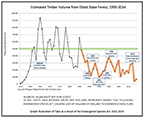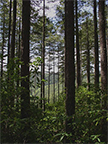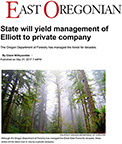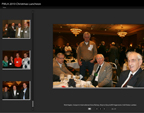Elliott State Educational Forest
(L-R) Wayne Giesy, Jerry Phillips, and David Gould discuss the history and 250-foot-height of the oldest, 250-year-old Douglas fir trees of the 52-acre "Silver Creek Heritage Grove" in the Elliott State Forest. The combined ages of these three men is greater than the age of the trees in this stand. Photo taken by Bob Zybach, July 8, 2017.
This Oregon Websites and Watersheds Project, Inc. (ORWW) educational website was launched February 16, 2017 by Dr. Bob Zybach, ORWW Program Manager, and Wayne Giesy, ORWW President. Its initial focus was the "Elliott State Educational Forest," a proposed 20-year public experiment. This research proposal was based on the original "Giesy Plan" for managing federal forestlands in the western US. The intent of the proposal was to retain the Elliott State Forest ("the Elliott") in public hands and to use it as a scientific demonstration of the Giesy Plan's practicality for creating local jobs and maintaining good schools, abundant wildlife, beautiful forests, and clean water -- while systematically reducing wildfire risks and damage on Oregon's (and other western United States') federal forestlands.
The creation of this website was in partial response to the Oregon State Land Board's (OSLB) February 14, 2017 decision to sell the Elliott to a private business without due consideration of the so-called "Giesy Plan Alternative." This proposal had been developed at the specific request of the State Governor in both private and public meetings and had been formally presented to the OSLB during their December 12, 2016 and February 14, 2017 meetings, without comment or discussion.
During the subsequent May 9, 2017 public meeting, the OSLB reversed its decision to sell the Elliott and on July 3, 2017 the State Legislature approved a bond for $100 million to "de-couple" the Elliott and the OSLB from their historical obligation to manage the Forest in accordance with School Trust Land obligations. On July 8, 2017, Wayne Giesy, Jerry Phillips, David Gould, and Bob Zybach toured the Elliott together and discussed what could be done under developing circumstances to best employ the Elliott for educational purposes, given the Forest's lack of current income and management options. Public education, in conformance with the ORWW Mission statement, was seen as one important strategy to pursue; which change in focus then became the primary purpose of this website.
"I'd been vaguely aware of the Forest’s existence since attending Oregon State College, where it was described in college literature as an undeveloped State-owned forest of young timber lying between Coos and Umpqua Rivers, dedicated to educational purposes." (Jerry Phillips 1998: iii)
 |
Economics. Economic records of the Elliott, summarized on an annual basis and by budgetary categories. Also includes economic projections, historical and current, by category. |
 |
Forestry. This topic regards the management of Elliott forest products, wildlife, aesthetics, workers, and visitors over time; short- and long-term objectives; quantitative and qualitative measures of success, failure, and improvement. |
History. Fire, family, and wildlife history of the Elliott, with a focus on the published works of Jerry Phillips, Aileen Rickard, Lionel Youst, and the accumulated written and photographic records of the George Gould-Hattie McClay family and descendants. |
|
| Maps. These JPEG maps are selected from the reports, magazine and news articles, government records and other documents contained in this website. They show the Elliott in reference to the State of Oregon; in relation to the other State Forests; legal boundaries; streams; topography; subbasins; fire history; early historical Oregon Indian Tribes; roads and trails; marbled murrelet, spotted owl, and coho habitat; and tree ages. | |
 |
News & Opinions. PDF files of recent (<10 years) newspaper articles, news blogs, website posts, editorials, & public letters regarding the current management and future direction of the Elliott. |
| Photographs. These JPEG photograph files have been provided by Jerry Phillips, taken from ORWW reports and articles by Dr. Zybach, donated or published by members of the Gould family, selected from the public domain, obtained during student field trips, and/or from other willing sources. The images are specific to the Elliott Forest and adjacent lands and are freely available for student use and public display. We ask that photograph sources and photographer names (when known) are properly cited for such uses. | |
 |
Politics. To this point, in addition to current news articles and public opinions: the political aspects of public ownership and management of the Elliott are mostly contained in the collected PDF files of Government Agency Records, including state & federal agency reports, meeting notes, public comments, and other governmental records; and in Legal Records, including recent (past 10 years) legal filings, judicial decisions, and informed commentary. |
| Recreation. This website focuses on recreational opportunities -- and particularly those with educational or financial advantage to Oregon schools and students -- afforded by the Elliott State Forest and by lands and businesses immediately adjacent to its perimeter. Six Educational Elliott Field Trips Current focus and content is provided by Tasha Livingstone and her 2018 Southwestern Oregon Community College (SWOCC) Forest Recreation students' draft 2018 SWOCC Draft Elliott Recreation Plan. | |
| References. PDF files specific to the Elliott, its history and management, are organized into five thematic categories: 1) Articles & Reports include research papers, popular magazine articles, and reports with scientific, economic, or political topics; 2) Agency Records include state and federal agency reports, meeting notes, public comments, etc.; 3) Historical Records includes books, journals, maps, photos, and other historical documentation 4) Legal Records include recent (past ten years) legal filings, judicial decisions, and commentary; 5) News Reports include newspaper articles, news blogs, website posts, editorials, and public letters. | |
| Research. The proposed "Giesy Plan Alternative" approach to management of the Elliott is a 20-year forest research project focused on active- vs. passive-management of the Forest's commercial resources and wildlife, while addressing traditional uses and legal obligations. As other research projects and proposals are uncovered or created that focus on the Elliott, they will also be documented here. | |
| Wildlife. Native and exotic wildlife populations of the Elliott, including vertebrate and invertebrate aquatic and terrestrial animals historically and/or currently present in the Forest. |
© 2017, 2018 Oregon Websites & Watersheds Project, Inc. & NW Maps Co.